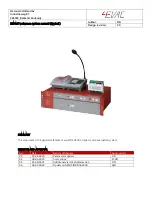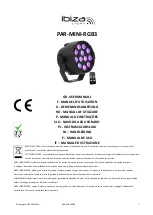
USE AND MAINTENANCE
ENGLISH
g
50
cod. G19502491
5.0.7 SETTING ASIDE
At the end of the season, or if a long period of rest is for seen it is
advisable:
1) Carefully empty all the seed from the hopper and distribution
assÕy.
2) Wash the equipment with a lot of water, especially the tanks,
and than dry them.
3) Carefully check worn or damaged parts and replace if
necessary.
4) Tighten all screws and bolts.
5) Grease the dnve chains, oil all the drive chains, spread
lubricant on all the parts not painted.
6) Protect the equipment with a (nylon) cover.
7) Then put it in a dry place, do not move it and where it is out of
reach of un authorized people.
If these operations are done carefully, it will be to the total
advantage of the user because when work is recommenced, he
will find the equipment in perfect conditions.
5.1 SUGGESTIONS IN CASE OF INCONVENIENCES
5.1.1 Clogging of the pipes
- Check, on the basis of the rotation test chart, the position of the
butterfly valves.
- The blades are clogged with wet soil
- The distribution pipes are bent somewhere.
- Foreign bodies in the distributor or blade.
- Respect the rpm, 540 or 1000, of the power take-off.
- The blower pump rpm has been reduced because of worn V-
belts
5.1.2 The amount of seed in kg/Ha does not correspond to the
values of the rotation test
The causes involved in the excessive amount of seeds dispersed
may be:
- the sealing rims are defective and no longer adhere, because
of wear or mice eating them away.
- during the rotation test the drive transmission wheel was turned
too fast.
The causes involved in an insufficient amount of seed dispersed
may be:
- dosing unit access clogged by foreign bodies.
- During the distribution of fine seeds cases can be verified in
which it has outside been exited of seeds from the dosage
system. Only in this case, to replace the protection (A, Fig. 44)
with the bulkheads (B) and (C) in equipment, like indicated in
Figure 44.
- during the rotation test the empty weight of the collecting
container was not taken into account and deducted.
- Insufficient movement of the hoist arms: the planting unit is not
free to follow the path of the soil, causing the transmission
wheel to slip (chapter 3.2.1 reference 3).
- When working at very slow speeds (less than 3 km/h), seed
planting may be irregular. In this case, please consult the
Manufacturer.
The differences due to slipping or excessive distribution at the
beginning of the field, are around 2-4%. Greater deviations can
be traced back exclusively to errors in the rotation test, to a wrong
transmission ratio or similar causes.
fig. 44
C
B
A
6.0 DEMOLITION AND DISPOSAL
This operation is to be carried out by the customer.
Before demolishing the machine, you are advised to carefully
check its physical condition and ascertain whether there are any
parts of the structure that may be susceptible to structural collapse
or breakage during demolition.
The customer should operate in compliance with the environment
protection laws in force in his/her country.
CAUTION
The machine demolition operations should be carried out by
skilled personnel only, equipped with suitable protective
clothing (safety footwear and gloves) and auxiliary tools and
equipment.
CAUTION
All the disassembly operations for demolition should be carried
out with the machine stopped and detached from the tractor.
Before demolishing the machine, you are advised to render
harmless all the parts that may be a source of danger and
therefore:
· scrap the structure using specialized firms,
· remove any electrical apparatus according to the laws in force,
· collect oils and greases separately, to be disposed of through
specialized firms, in accordance with the regulations of the
country in which the machine was used.
When the machine is demolished the CE mark should be
destroyed together with this manual.
Last but not least, we remind you that the manufacturer is
always available for any and all necessary assistance and
spares.
Summary of Contents for PINTA
Page 4: ...g 4 cod G19502491...
Page 27: ...g 27 cod G19502491 Notes...
Page 28: ...g 28 cod G19502491...
Page 51: ...g 51 cod G19502491 Notes...
Page 52: ...g 52 cod G19502491...
Page 75: ...g 75 cod G19502491 Notes Notes Notes Notes Notes...
Page 76: ...g 76 cod G19502491...
Page 99: ...g 99 cod G19502491 Notes...
Page 100: ...g 100 cod G19502491...
Page 123: ...g 123 cod G19502491 Notes...
Page 124: ...g 124 cod G19502491...
















































